Features of huts

An overnight stay or just outdoor recreation can be brightened up with some skills. An important skill is the construction of a hut in any conditions. This will make it possible not only to make active recreation more interesting, but also to diversify the pastime at your own dacha. A hut can even be built on a tree.
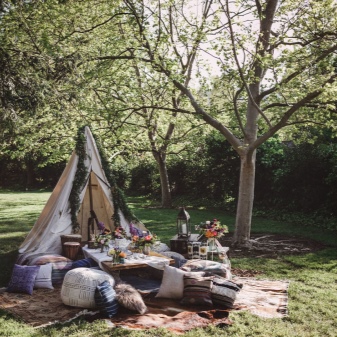
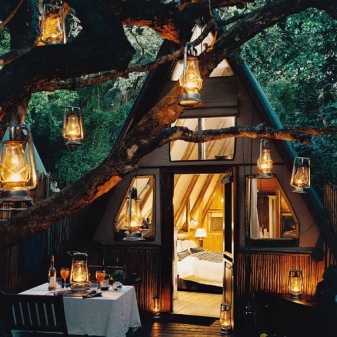
What it is?
The hut can be made absolutely anywhere and at any time. It is usually built on a camping trip for an overnight stay or just for fun. Almost any material is suitable for construction: branches, tree roots or boards. Fans of outdoor activities and just walks in the woods build such facilities for the night. And also in the hut, you can just relax and eat harvested berries.
Many children love to build these structures for play. They can do it on their own at home, in a room. Parents can easily build a tree hut in the country. By the way, during the hike, you can teach children to make field buildings. This is a pretty useful skill for general development.
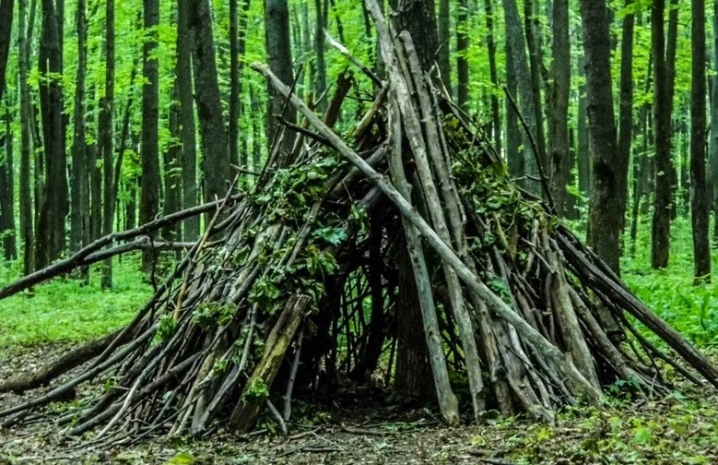
You need to build a hut on a plain, in a wooded area among spreading trees or lush bushes. Such vegetation can provide additional protection from the wind. Also, this location allows you to hide from animals and tourists. It is not worth setting up a hut near rocky or sandy slopes, near rough water bodies and single trees, in open meadows.
If there is a fire inside, then the ground must first be cleared of twigs and foliage.
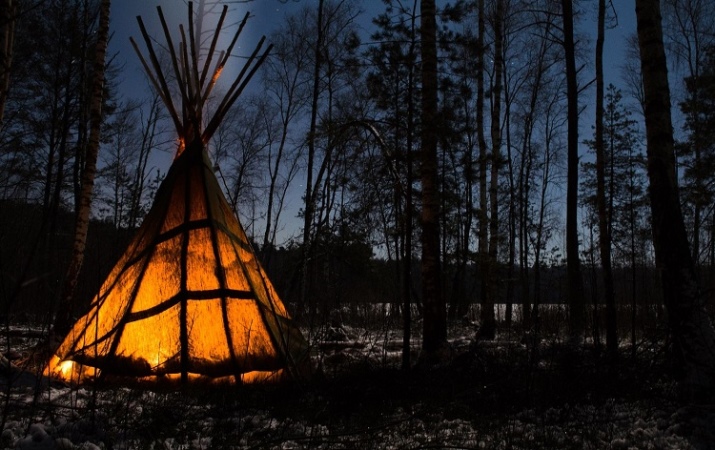
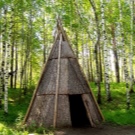
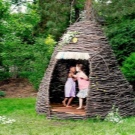


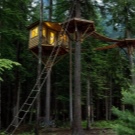
Species overview
There are three types of huts, which differ in design and construction complexity. There are also quite interesting interpretations woven from brushwood. This is a completely different level that requires a lot of material and free time. Usually, such options are equipped in the country or in your yard for frequent use and games with children. Any hut can be both large and small, depending on the purpose of use.

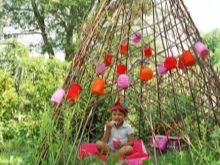
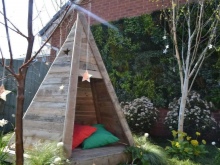
There are quite interesting building ideas that allow you to spend more than one night in the wild. To create more complex huts, you will have to gain experience; their construction also requires a large amount of materials. High-quality construction allows you to hide from bad weather and insects, to protect yourself from small wild animals.
Even the simplest hut will allow you to sit out strong sun or light rain.
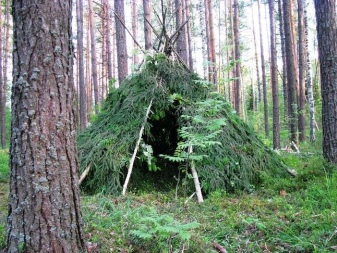
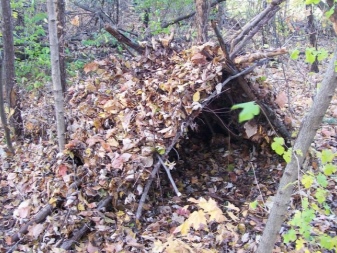
Single slope
The easiest type of hut to manufacture. Basically, it is a canopy that is angled at 45 ° or 60 °. Such a structure can be made from twigs and leaves. A tree serves as a support. Pros:
- it is built quickly and easily;
- protects from the sun and rain;
- does not require special materials and skills.
It should be noted that such a hut only partially protects from the wind. Sometimes the rain can just blow under the structure. Minuses:
- will not protect against cold, rain, insects and wild animals;
- you will have to look for a suitable tree that will serve as a support.
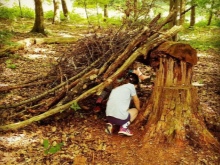
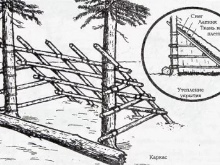
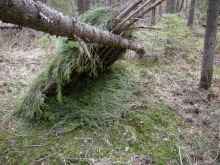
Gable
Visually resembles a tourist tent. For the construction, they first make a frame, then they cover it with spruce and other branches, moss. Pros:
- protects from adverse weather conditions;
- relatively easy to build.
The very principle of construction is similar to the previous type. Only now the gable hut has walls on both sides. Minuses:
- it will take a lot of materials and time to build;
- making a fire for heating will be quite difficult.
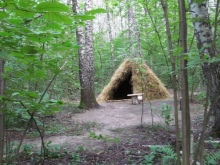
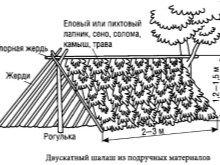

Circular
The hut looks like a wigwam, in the shape of a cone. It is rather difficult to make such a construction. Set up around a tree or stake, securely anchored in the ground. Pros:
- if done correctly, it will become a good protection from bad weather, wild animals and insects;
- inside you can light a fire for heating;
- looks pretty attractive.
It is important not to leave the fire in the hut unattended. The materials used are highly flammable. Minuses:
- it is quite difficult to build, certain skills will be required;
- during the construction, in any case, help will be required, alone to cope with the task will not work.
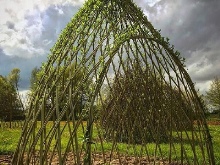


How to make an outdoor hut with your own hands?
Each building consists of certain parts, elements. There is always a skeleton. The frame is constructed from poles. Covering material is laid on top. Additionally, you will need fasteners, it can even be scotch tape, harnesses, tree roots. The covering material can be divided into 2 types. Some elements simply fit into the frame, or even are.
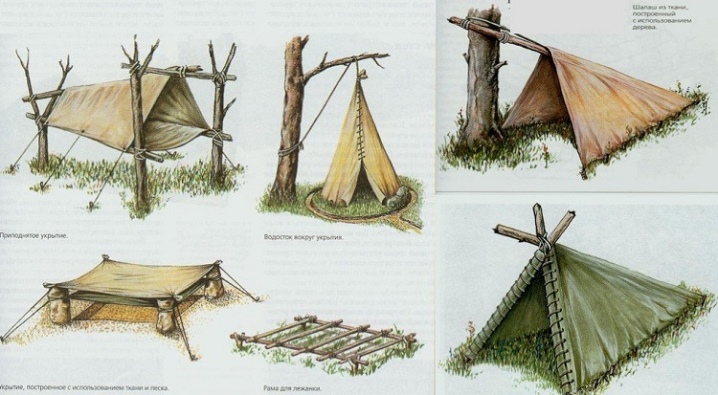
Other materials require additional reinforcement on the core. The former are easier to do, but if done correctly, they can be quite reliable and durable. If necessary, you can read the instructions for the correct choice of covering material.

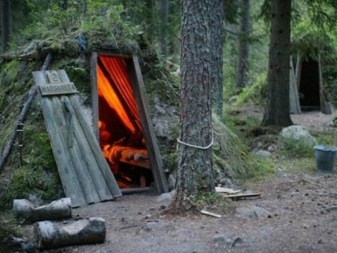
The ideal option for covering is reed, while reeds are a little worse. Reed-reed lining is stacked in sheaves. The big advantage is that this material is not easily flammable. And the branches are strong and rather heavy.
You don't even need to fasten the gable hut with ropes, the lining will not blow off. A simpler solution is straw cover... A hut of this type will protect you from bad weather and a little cold. However, straw is very easy to catch fire, making a fire to heat the inside is prohibited.
The material is pre-tied into sheaves, and then tied up. This will require a lot of rope and twine.
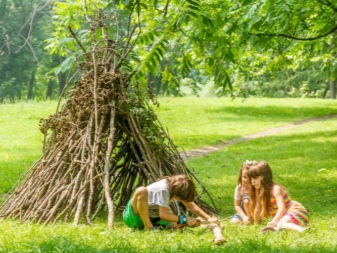

Spruce branches not worse than straw in properties, but less flammable. A deciduous hut can be equipped only in summer, in winter you will need a fir or spruce. A special fresh aroma is considered an additional benefit. It not only has a beneficial effect on the body, but also provides additional protection against mosquitoes.
A spring-summer hut made of scrap materials can be overlaid with bracken fern leaves. You can even make a fire inside for heating. Mosquitoes do not fly into such a structure. It is worth noting that the fern releases a substance into the air that can provoke headaches in the morning.
A hut with such a covering is contraindicated for children.
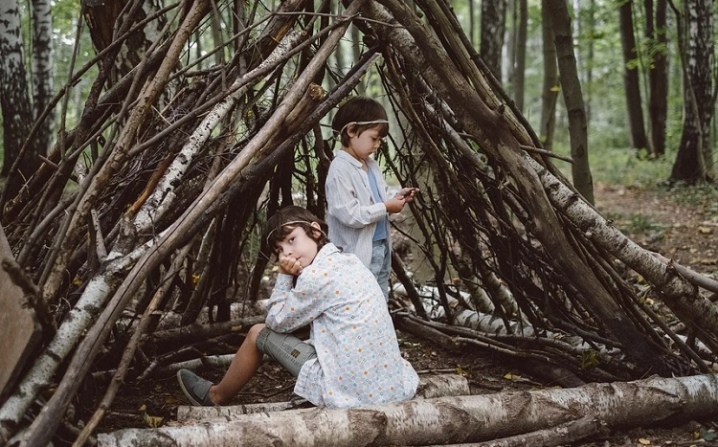
Sometimes buildings are covered with moss, but this is also not the best option. The heavy smell will be extremely unpleasant, insects can fall inside. Moreover, during sporulation, moss provokes strong allergic reactions. Such a hut should not be considered if there are children. Fresh pine branches play the role of both frame and cover at the same time. The tops are tied or woven, depending on the season. In winter, the hut can be additionally insulated with snow.
Mosquitoes fly around the summer building made of pine branches, but you cannot start a fire inside. A good solution for a children's hut during a picnic, hike.
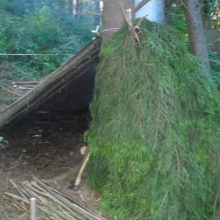
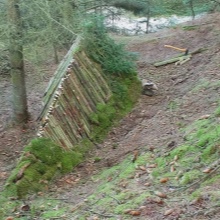
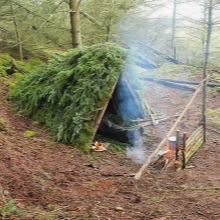
Of course, the covering material can also be something unnatural. Any technical fabric, tarpaulin is suitable. Stretch film can be used to protect against water so that even heavy rain is not terrible. The hut turns out to be practical, but not very natural. Additional materials may be needed. We'll have to build a kind of crate, laying branches on the frame. The frame will have to be strengthened with poles about 7 cm thick made of good wood. Sticks need to be dug deeper into the ground. So the construction will be more laborious, but there will be much more coverage options.
You can make a thick, small-flowing coating. To protect against bad weather, a layer of at least 20 cm is needed. With a slight strengthening of the frame, dry grass can be thrown over the hut.Its properties are the same as that of hay. True, this material does not need to be bandaged, which simplifies the task. And the reed can not be knitted if the frame is strengthened.
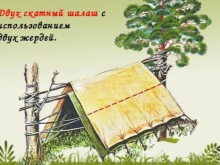

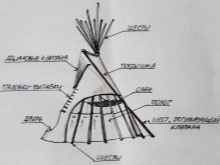
In the woods
The easiest way is to make a lean-to hut. It will allow you to sit out a little rain or sun. A good solution if time and materials are short. Branches that are nearby are used. A homemade simple hut can be done like this.
- A suitable location should be chosen. The clearing must be dry and at a height. The hut should be arranged a few meters from a reliable support tree.
- Cut down a reliable 2.5 meter pole. Lay it on the branches of the support tree so that the height from the ground is about 1.5 meters.
- Prepare the ramp poles. Fasten them to the main crossbar with tape, bark or roots. So the frame is ready.
- Cover the hut with branches, leaves and spruce branches in the same sequence.
- Hammer in the stakes in the end parts of the hut. Arrange small branches tightly.
- You can lay grass or spruce branches on the floor. If the layer is at least 30 cm, then you can sleep without the risk of freezing.
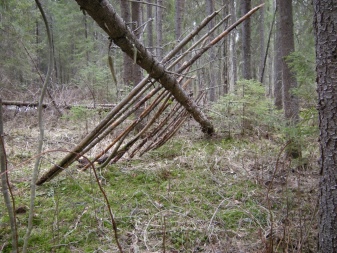
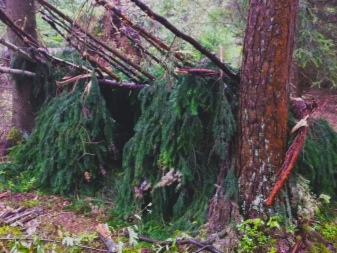
You can spend the night in such a hut if you properly prepare for this. In the summer, problems should not arise at all. Near the hut there is an opportunity to make a fire for additional heating at night. A reflector made of intertwined fixed stakes with branches can be placed behind the fire. So the heat will be directed precisely into the hut. For spending the night, you can also put a gable hut. For him, you will have to collect a large amount of materials.
Here's a quick guide.
- Clear the ground from stones and debris. Make sure there are no nests or burrows nearby.
- For the skeleton, 2 large sticks with branches at the top are used. The lower parts are sharpened, driven deeper into the ground.
- A pole should be installed on the base. For fixation, tape, rope, grass or roots are used.
- Tie thick poles on both sides. Fix near the main structure with stakes. Tie on top with tape or any other suitable material.
- Make the top deck out of the available material. If it does not burn, then you can make a fire in the hut.
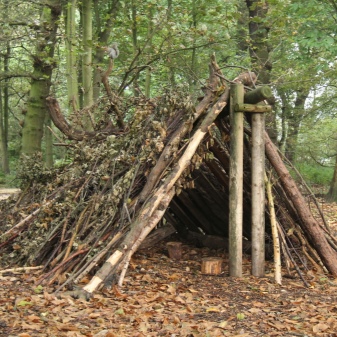
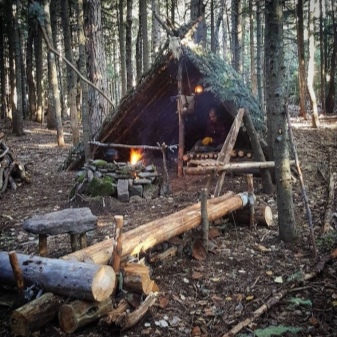
In the country
In the yard or in the garden, you can build an interesting place to play. A hut for a child in the country should be built according to the scheme, there are quite interesting projects. A good hut will even allow you to sit out the downpour. You can make a simple structure out of pallets or planks. It can be either a gable version or a single-pitch version. And also a beautiful circular hut with a fabric looks good in the yard.
Before starting construction, a drawing with dimensions should be made.
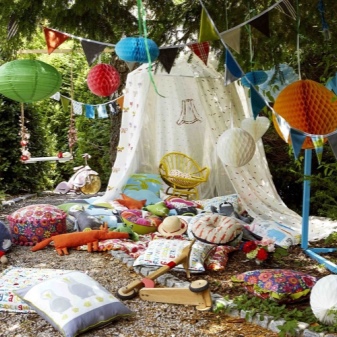

Necessary materials:
- waterproof fabric for the base - 3 by 1.5 m;
- window net (tulle, nylon) - 50 cm;
- sticks - 4 pcs. 1.8 m each;
- rope;
- Velcro tape.


And to simplify the work, you can take a drill. It is better to choose a technical fabric so that it does not get wet and protects from the wind. To make a hut, you just need to sew a cover and make a frame. The sticks for the frame are attached to each other from above with screws or tied. The undersides need to be sharpened to deepen into the ground. The hut is installed after the fabric is stretched over the frame. You can make the structure larger. Shape change is allowed.
Additionally, you can equip the hut with pockets for storing toys or books for children.
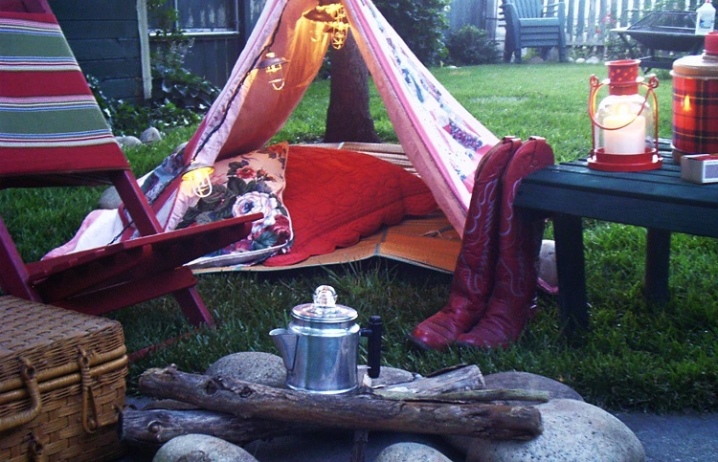
On the tree
Such a structure is installed for children's games. It is important to make a clear drawing in advance with all dimensions, think over the nuances of safety. It is worth noting that it is dangerous to leave small children unattended in a tree. The manufacturing features are as follows.
- The house can be installed only on a large branched tree. The base platform must fit.
- It is necessary to knock down the shield from the boards and attach it to the most reliable branches.
- Screw it to the base at the corners of the rack using self-tapping screws.
- Form the walls from the planks. A house 2 meters long is considered quite comfortable.The height should be selected based on the height of the children.
- The roof can be made of roofing material or metal. Slate cannot be used, it weighs too much.
- Nail down the rungs or install a rope ladder.
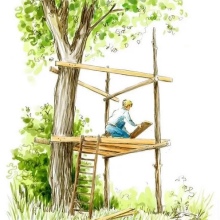
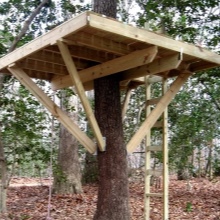
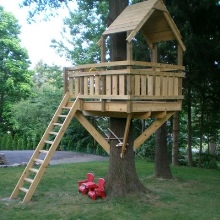
Indoor hut options
In an apartment or in a house, you can make an interesting place for children's games. Usually huts are installed in a room or on a balcony. The shelter can even be located on the bed. In this case, canopies are used for the arrangement.
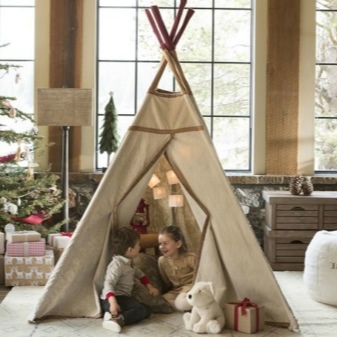

The simplest hut is made of chairs. A large blanket is stretched between the two chairs. Inside, you can throw pillows and put a blanket. It will be interesting if you install a small garland or a flashlight for more believability.
A more complex wigwam hut can be sewn from fabric.

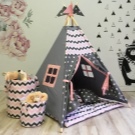
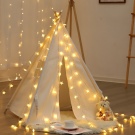
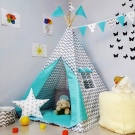

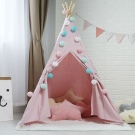
Arrangement inside
The hut must protect from bad weather. It is important to make sure that it is comfortable inside. A properly equipped hut will not only create coziness, but also prevent you from freezing at night.

Basic rules and recommendations.
- The floor must be covered with straw or dry leaves.
- If the building is in the country, then you can throw a mattress, blanket or blanket on the floor.
- It is recommended to make a door for spending the night. The use of fabric is allowed. You can weave a gate from branches. The structure will better retain heat, and the risk of insect penetration will decrease.
- For a summer hut, the entrance can be made from a mesh. It will also keep mosquitoes out, but will not obstruct air circulation.
- You can attach a flashlight to the rope to keep it light.

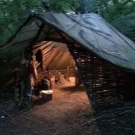
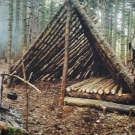
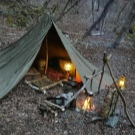

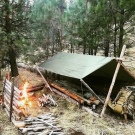
Interesting examples
The hut can be positioned outdoors during a hike or in the backyard of the house just for fun. And the structure can also be a place for a child to play inside an apartment. There are quite a few options for the execution of the hut, it all depends on the purpose. We suggest that you familiarize yourself with interesting examples.
- A lean-to hut. This one will definitely last a long time, and there is enough space inside for a family.
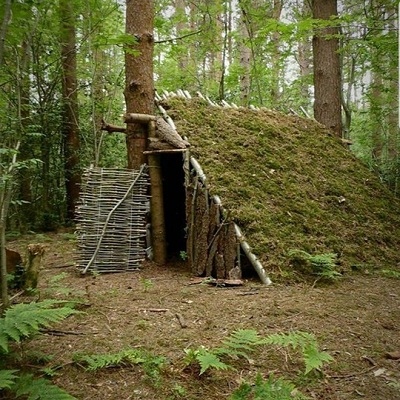
- A gable hut with a reinforced frame and thick flooring on top. It is interesting that the walls are additionally processed with clay, so the building looks like a full-fledged house.

- A circular hut with a hardwood cover material. Such a structure is not at all easy to make, but it is very comfortable to spend the night inside.

- A very interesting wicker hut for a summer residence. A full-fledged fortress for children's games.
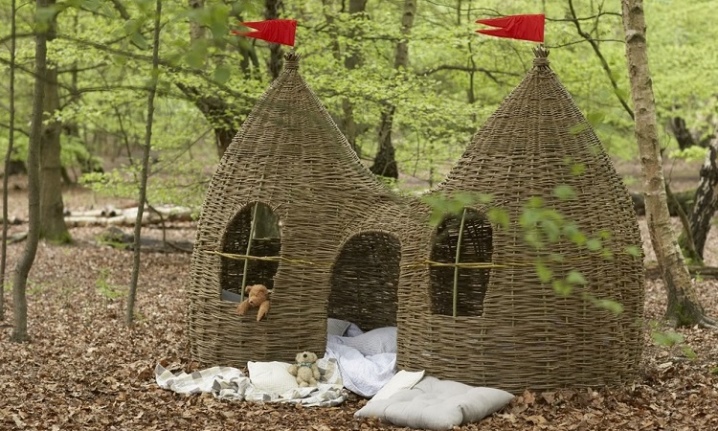
- A fabric tree hut is suitable for the summer season, just for the holidays. The design is simple, but it looks just mesmerizing.
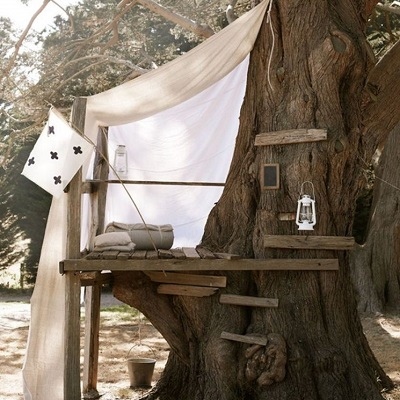
- A complete tree house. Such a hut requires a lot of work, but the result is worth it.
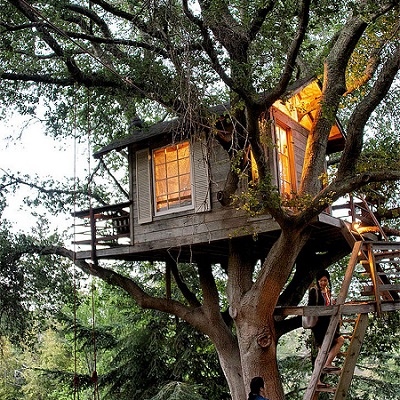
For information on how to quickly build a hut in the forest without nails and ropes, see the next video.



























































The comment was sent successfully.